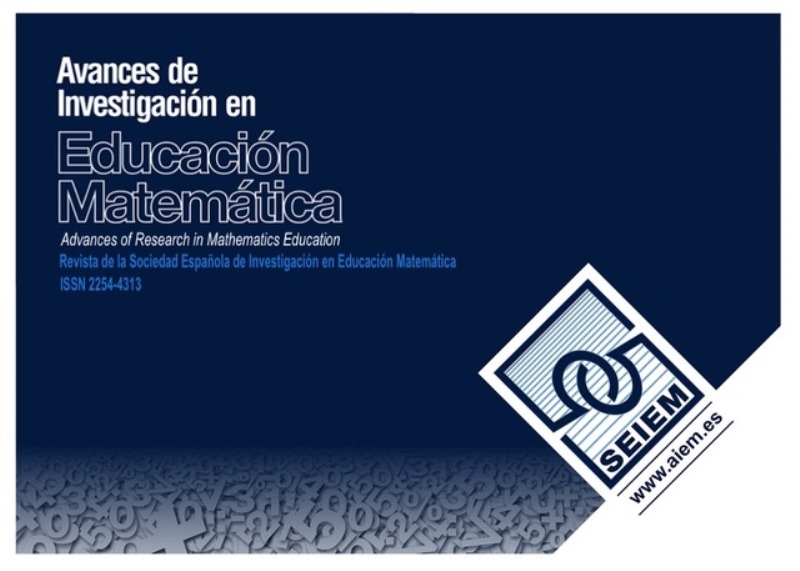The Role Played by Extra-mathematical Connections in the Modelling Process
DOI:
https://doi.org/10.35763/aiem25.6363Keywords:
Extra-mathematical connection, Mathematical modelling, Onto-semiotic approachAbstract
Literature review in Mathematics Education on connections makes evident the necessity of delving into extra-mathematical connections. In this line, we answer the question: What types of mathematical connections are required to develop the modelling process? To this end, we consider three theoretical references: Onto-Semiotic Approach, Extended Theory of Connections, and Mathematical Modelling Cycle from a Cognitive Perspective, following a methodology used in two theoretical articulations previously developed by the authors between these frameworks, based on the use of models for the analysis of mathematical activity proposed by the Onto-Semiotic Approach for connections and the modelling process. The results of this analysis consist of, on one hand, the evidence of the types of intra- and extra-mathematical connections intervening in the different phases of the modelling cycle and, on the other hand, the proposal of a more detailed classification of mathematical connections.
Downloads
References
Abassian, A., Safi, F., Bush, S., & Bostic, J. (2020). Five different perspectives on mathematical modeling in mathematics education. Investigations in Mathematics Learning, 12(1), 53-65. https://doi.org/10.1080/19477503.2019.1595360
Blum, W. (2002). ICMI Study 14: Applications and modelling in mathematics education - Discussion document. Educational Studies in Mathematics, 51(1-2), 149-171. https://doi.org/10.1023/a:1022435827400
Borromeo Ferri, R. (2006). Theoretical and empirical differentiations of phases in the modelling process. Zentralblatt für Didaktik der Mathematik, 38(2), 86-95. https://doi.org/10.1007/bf02655883
Borromeo Ferri, R. (2018). Learning How to Teach Mathematical Modeling in School and Teacher Education. Springer. https://doi.org/10.1007/978-3-319-68072-9
Breda, A., Hummes, V., da Silva, R. S., & Sánchez, A. (2021). El papel de la fase de observación de la implementación en la metodología Estudio de Clases. BOLEMA: Boletim de Educação Matemática, 35(69), 263-288. https://doi.org/10.1590/1980-4415v35n69a13
Businskas, A. M. (2008). Conversations about connections: How secondary mathematics teachers conceptualize and contend with mathematical connections [Unpublished Doctoral dissertation] Simon Fraser University. LAC’s Library Catalogue. https://bac-lac.on.worldcat.org/oclc/755208445
Dolores-Flores, C., & García-García, J. (2017). Conexiones intramatemáticas y extramatemáticas que se producen al resolver problemas de cálculo en contexto: Un estudio de casos en el nivel superior. BOLEMA: Boletim de Educação Matemática, 31(57), 158-180. https://doi.org/10.1590/1980-4415v31n57a08
Eli, J. A., Mohr-Schroeder, M. J., & Lee, C. W. (2011). Exploring mathematical connections of prospective middle-grades teachers through card-sorting tasks. Mathematics Education Research Journal, 23(3), 297-319. https://doi.org/10.1007/s13394-011-0017-0
Evitts, T. A. (2004). Investigating the mathematical connections that preservice teachers use and develop while solving problems from reform curricula (Publication No. 3157533) [Unpublished doctoral dissertation] The Pennsylvania State University. ProQuest Dissertations and Theses Global.
Font, V., & Contreras, Á. (2008). The problem of the particular and its relation to the general in mathematics education. Educational Studies in Mathematics, 69(1), 33-52. https://doi.org/10.1007/s10649-008-9123-7
Font, V., Godino, J. D., & Gallardo, J. (2013). The emergence of objects from mathematical practices. Educational Studies in Mathematics, 82(1), 97-124. https://doi.org/10.1007/s10649-012-9411-0
García-García, J., & Dolores-Flores, C. (2021a). Pre-university students’ mathematical connections when sketching the graph of derivative and antiderivative functions. Mathematics Education Research Journal, 33(1), 1-22. https://doi.org/10.1007/s13394-019-00286-x
García-García, J., & Dolores-Flores, C. (2021b). Exploring pre-university students’ mathematical connections when solving Calculus application problems. International Journal of Mathematical Education in Science and Technology, 52(6), 912-936. https://doi.org/10.1080/0020739X.2020.1729429
Kaiser, G. (2020). Mathematical modelling and applications in education. In S. Lerman (Ed.), Encyclopedia of Mathematics Education (2nd ed.) (pp. 553-561). Springer. https://doi.org/10.1007/978-3-030-15789-0_101
Ledezma, C., Font, V., & Sala, G. (2023). Analysing the mathematical activity in a modelling process from the cognitive and onto-semiotic perspectives. Mathematics Education Research Journal, 35(4), 715-741. https://doi.org/10.1007/s13394-022-00411-3
Preciado, A. P., Peña, F., Ortiz, Y. A., & Solares, A. (2023). Diversity of perspectives on mathematical modelling: A review of the international landscape. In G. Greefrath, S. Carreira, & G. A. Stillman (Eds.), Advancing and Consolidating Mathematical Modelling: Research from ICME-14 (pp. 43-57). Springer. https://doi.org/10.1007/978-3-031-27115-1_3
Rodríguez-Nieto, C., Rodríguez-Vásquez, F., & Font, V. (2022). A new view about connections: The mathematical connections established by a teacher when teaching the derivative. International Journal of Mathematical Education in Science and Technology, 53(6), 1231-1256. https://doi.org/10.1080/0020739X.2020.1799254
Rodríguez-Nieto, C. A., Rodríguez-Vásquez, F. M., & Font, V. (2023). Combined use of the extended theory of connections and the onto-semiotic approach to analyze mathematical connections by relating the graphs of f and f’. Educational Studies in Mathematics, 114(1), 63-88. https://doi.org/10.1007/s10649-023-10246-9
Downloads
Published
How to Cite
Issue
Section
License
Copyright (c) 2024 Carlos Ledezma, Camilo Andrés Rodríguez-Nieto, Vicenç Font

This work is licensed under a Creative Commons Attribution 4.0 International License.
The articles published in this journal are under a license Creative Commons: By 4.0 España from number 21 (2022).
Authors who publish with this journal agree to the following terms:
- Authors retain copyright and keep the acknowledgement of authorship.
- The texts published in this journal are – unless indicated otherwise – covered by the Creative Commons Attribution 4.0 international licence. You may copy, distribute, transmit and adapt the work, provided you attribute it (authorship, journal name, publisher) in the manner specified by the author(s) or licensor(s). The full text of the licence can be consulted here: http://creativecommons.org/licenses/by-nc/4.0.
- Authors are able to enter into separate, additional contractual arrangements for the non-exclusive distribution of the journal's published version of the work (e.g., post it to an institutional repository or publish it in a book), with an acknowledgement of its initial publication in this journal.
- Authors are permitted and encouraged to post their work online (e.g., in institutional repositories or on their website) prior to and during the submission process, as it can lead to productive exchanges, as well as earlier and greater citation of published work (See The Effect of Open Access).
Funding data
-
Agencia Estatal de Investigación
Grant numbers PID2021-127104NB-I00









